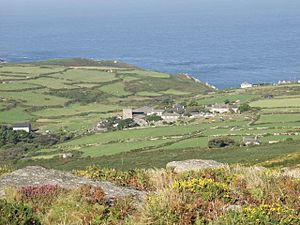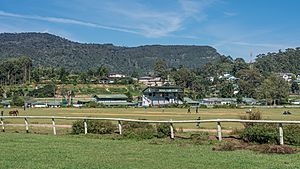Oceanic climate facts for kids
An oceanic climate, also known as a maritime climate, is a type of weather where winters are cool or mild, and summers are not dry or very hot. Places with this climate often have weather that changes frequently. Most oceanic climates are classified as Cfb in the Köppen climate classification. This means they have moderate to high rainfall in every season and warm summers.
Some cities with this climate include Dublin, London, Bergen, Paris, Melbourne, and Auckland. There's also a colder version called a subpolar oceanic climate (Cfc), which has shorter summers, like in the Faroe Islands. Sometimes, a subtropical highland climate (Cwb and Cwc) is also considered a type of oceanic climate.
Contents
What is the Weather Like in an Oceanic Climate?
Rain and Clouds
Areas with oceanic climates often have cloudy skies and a lot of rain. You might see low-hanging clouds and frequent weather fronts or storms. Thunderstorms are usually rare. For most of the year, rain is the main type of precipitation. However, most oceanic climate zones get at least one snowfall each year. Snow is more common in subpolar oceanic climates because they are colder.
Temperatures
Oceanic climates generally have cool temperatures without extreme highs or lows. In the Köppen climate classification, the coldest month has an average temperature of 0 °C (32 °F) or warmer. This is different from continental climates, where the coldest month is much colder.
Summers in oceanic climates are warm but not hot. The warmest month usually has an average temperature below 22 °C (72 °F). Further north or south, there's a subpolar oceanic climate (Köppen Cfc). These places have long but mild winters for their latitude, and cool, short summers. Their average temperatures are at least 10 °C (50 °F) for one to three months.
Types of Oceanic Climates
Marine West Coast (Cfb)
| Weather chart for Plymouth, United Kingdom | |||||||||||||||||||||||||||||||||||||||||||||||
|---|---|---|---|---|---|---|---|---|---|---|---|---|---|---|---|---|---|---|---|---|---|---|---|---|---|---|---|---|---|---|---|---|---|---|---|---|---|---|---|---|---|---|---|---|---|---|---|
| J | F | M | A | M | J | J | A | S | O | N | D | ||||||||||||||||||||||||||||||||||||
|
108
9
4
|
84
9
4
|
78
11
5
|
67
13
6
|
64
16
9
|
57
18
11
|
62
20
13
|
67
20
13
|
74
18
12
|
113
15
9
|
113
12
6
|
119
10
5
|
||||||||||||||||||||||||||||||||||||
| temperatures in °C precipitation totals in mm |
|||||||||||||||||||||||||||||||||||||||||||||||
|
Imperial conversion
|
|||||||||||||||||||||||||||||||||||||||||||||||
This type of oceanic climate is also called "marine mild winter" or simply "oceanic." It's often found on or near the west coasts of continents, which is why it's also known as "marine west coast climates." Besides mild temperatures all year, a key feature is that there is no dry season.
Ocean currents and western sea breezes help keep temperatures mild, especially in winter. They also cause cloudy weather. Rain falls steadily, especially in colder months. This climate can extend further inland if there are no mountains blocking the ocean air.
Because there's enough moisture all year and not much deep snow, plants grow very well here. You'll often see deciduous trees (trees that lose their leaves). But conifers like spruce and pine are also common. Fruits like apples, pears, and grapes can often be grown here.
In the warmest month, the average temperature is below 22 °C (72 °F). At least four months have average temperatures higher than 10 °C (50 °F). The coldest month's average temperature is not colder than −3–0 °C (27–32 °F). If it were colder, it would be a continental climate. The average yearly temperature changes are usually between 10–15 °C (50–59 °F).
Cfb climates are common in most of Europe. They are also the main climate type in New Zealand and parts of Australia like Tasmania and Victoria. In North America, you can find them in Washington, Oregon, and parts of British Columbia. Some areas in southern Chile and Argentina also have this climate. In South Africa, it's found along parts of the coastline.
Subtropical Highland Variety (Cfb, Cwb)
| Weather chart for Mexico City | |||||||||||||||||||||||||||||||||||||||||||||||
|---|---|---|---|---|---|---|---|---|---|---|---|---|---|---|---|---|---|---|---|---|---|---|---|---|---|---|---|---|---|---|---|---|---|---|---|---|---|---|---|---|---|---|---|---|---|---|---|
| J | F | M | A | M | J | J | A | S | O | N | D | ||||||||||||||||||||||||||||||||||||
|
11
21
6
|
4.3
23
7
|
10
26
9
|
26
27
11
|
56
27
12
|
135
25
12
|
175
23
12
|
169
23
12
|
145
22
12
|
67
22
10
|
12
22
8
|
6
21
7
|
||||||||||||||||||||||||||||||||||||
| temperatures in °C precipitation totals in mm |
|||||||||||||||||||||||||||||||||||||||||||||||
|
Imperial conversion
|
|||||||||||||||||||||||||||||||||||||||||||||||
| Weather chart for Addis Ababa, Ethiopia | |||||||||||||||||||||||||||||||||||||||||||||||
|---|---|---|---|---|---|---|---|---|---|---|---|---|---|---|---|---|---|---|---|---|---|---|---|---|---|---|---|---|---|---|---|---|---|---|---|---|---|---|---|---|---|---|---|---|---|---|---|
| J | F | M | A | M | J | J | A | S | O | N | D | ||||||||||||||||||||||||||||||||||||
|
17
23
9
|
36
24
9
|
68
25
11
|
89
25
12
|
76
25
13
|
124
23
12
|
259
21
12
|
278
20
12
|
174
22
12
|
41
23
10
|
8.3
23
8
|
10
22
8
|
||||||||||||||||||||||||||||||||||||
| temperatures in °C precipitation totals in mm |
|||||||||||||||||||||||||||||||||||||||||||||||
|
Imperial conversion
|
|||||||||||||||||||||||||||||||||||||||||||||||
The subtropical highland climate is a type of climate found in mountains or high areas in subtropical or tropical parts of the world. Even though they are in warmer latitudes, their high elevation means they share features with oceanic climates.
Some subtropical highland climates (Cfb) have rain spread evenly throughout the year, like other oceanic climates. However, they have bigger temperature changes between day and night and lower humidity because they are inland and high up. Other subtropical highland climates (Cwb) are affected by monsoons, meaning they have distinct wet summers and dry winters.
Outside the tropics, these climates are very similar to oceanic climates, with mild summers and noticeably cooler winters, sometimes with snow. In tropical areas, a subtropical highland climate feels like spring all year. Temperatures stay fairly constant, and snow is rare because winters are warmer than in most oceanic climates.
Areas with this climate have monthly average temperatures below 22 °C (72 °F) but above −3 °C (27 °F). At least one month's average temperature is below 18 °C (64 °F). Without their high elevation, many of these places would have humid subtropical or tropical weather.
You can find this climate in parts of eastern, southern, and southeastern Africa, mountainous areas of North America, and the Tropical Andes in South America. It's also in parts of Yunnan in China, the Himalayas, and some Hawaiian Islands.
Subpolar Oceanic and Cold Subtropical Highland Varieties (Cfc, Cwc)
| Weather chart for Punta Arenas, Chile | |||||||||||||||||||||||||||||||||||||||||||||||
|---|---|---|---|---|---|---|---|---|---|---|---|---|---|---|---|---|---|---|---|---|---|---|---|---|---|---|---|---|---|---|---|---|---|---|---|---|---|---|---|---|---|---|---|---|---|---|---|
| J | F | M | A | M | J | J | A | S | O | N | D | ||||||||||||||||||||||||||||||||||||
|
42
14
7
|
31
14
7
|
38
12
5
|
40
10
3
|
41
7
1
|
27
4
-1
|
29
4
-1
|
30
5
-0
|
27
8
1
|
27
10
3
|
30
12
5
|
33
14
6
|
||||||||||||||||||||||||||||||||||||
| temperatures in °C precipitation totals in mm |
|||||||||||||||||||||||||||||||||||||||||||||||
|
Imperial conversion
|
|||||||||||||||||||||||||||||||||||||||||||||||
Subpolar oceanic climates are a colder type of oceanic climate, usually found closer to the polar regions. They have long but relatively mild winters and short, cool summers. Snowfall is more common here than in other oceanic climates. These climates are less likely to have extreme temperatures than subarctic climates.
Subpolar oceanic climates have only one to three months where the average monthly temperature is at least 10 °C (50 °F). None of their average monthly temperatures fall below −3.0 °C (26.6 °F). Typically, in the warmest month, daytime high temperatures are below 17 °C (63 °F). In the coldest month, highs are near or slightly above freezing, and lows are just below freezing. This climate usually has a Cfc classification. Very small areas in Argentina and Chile have summers so short that they are Cwc, with fewer than four months over 10 °C (50 °F).
This climate is found in coastal Iceland, the Faroe Islands, parts of Scotland and Northern England, coastal Norway, the Aleutian Islands of Alaska, and parts of southern Argentina and Chile. It's also in some highland areas of Tasmania and the Australian Alps.
Small areas in Yunnan, Sichuan, Bolivia, and Peru have Cwc climates due to high altitudes and short summers. El Alto, Bolivia, is one town with this cold subtropical highland climate.
Examples of Places with Oceanic Climates
Africa
- Addis Ababa, Ethiopia (Cwb)
- Antananarivo, Madagascar (Cwb)
- Eldoret, Kenya (Cfb)
- George, Western Cape, South Africa (Cfb)
- Harare, Zimbabwe (Cwb)
- Kabale, Uganda (Cfb)
- Johannesburg, Gauteng, South Africa (Cwb)
- Maseru, Lesotho (Cfb, bordering on Cwb)
- Mthatha, Eastern Cape, South Africa (Cfb, bordering on Cfa)
- Nairobi, Kenya (Cwb)
- Port Elizabeth, Eastern Cape, South Africa (Cfb)
- Tristan da Cunha, United Kingdom (Cfb)
Asia
- Artvin, Turkey (Cfb, bordering on Csb)
- Brinchang, Pahang, Malaysia (Cfb)
- Hakha, Myanmar (Cwb)
- İnebolu, Turkey (Cfb)
- Kodaikanal, Tamil Nadu, India (Cfb)
- Kunming, China (Cwb)
- La Trinidad, Philippines (Cwb)
- Nuwara Eliya, Sri Lanka (Cfb)
- Phongsali, Laos (Cwb)
- Sa Pa, Vietnam (Cfb)
- Shimla, Himachal Pradesh, India (Cwb)
- Thimphu, Bhutan (Cwb, bordering on Cwa)
Europe
- Amsterdam, North Holland, Netherlands (Cfb)
- Andorra la Vella, Andorra (Cfb)
- Belfast, Northern Ireland, United Kingdom (Cfb)
- Bergen, Vestland, Norway (Cfb)
- Berlin, Germany (Cfb)
- Bern, Switzerland (Cfb, bordering on Dfb)
- Bilbao, Basque Country, Spain (Cfb)
- Bordeaux, France (Cfb, bordering on Cfa)
- Brussels, Belgium (Cfb)
- Cardiff, Wales, United Kingdom (Cfb)
- Copenhagen, Denmark (Cfb)
- Corvo Island, Azores, Portugal (Cfb, bordering on Cfa)
- Dublin, Ireland (Cfb)
- Frankfurt, Germany (Cfb)
- Glasgow, Scotland, United Kingdom (Cfb)
- Gothenburg, Västra Götaland County, Sweden (Cfb)
- Győr, Hungary (Cfb, bordering on Cfa/Dfa/Dfb)
- Hamburg, Germany (Cfb)
- Ljubljana, Slovenia (Cfb, bordering on Cfa)
- Lofoten, Nordland, Norway (Cfb, bordering on Cfc)
- London, England, United Kingdom (Cfb)
- Luxembourg City, Luxembourg (Cfb)
- Malmö, Skåne County, Sweden (Cfb)
- Munich, Bavaria, Germany (Cfb, bordering on Dfb)
- Ørland, Trøndelag, Norway (Cfb)
- Paris, France (Cfb)
- Penzance, England, United Kingdom (Cfb)
- Prague, Czech Republic (Cfb, bordering on Dfb)
- Santander, Cantabria, Spain (Cfb)
- Santiago de Compostela, Galicia, Spain (Cfb)
- Sarajevo, Bosnia and Herzegovina (Cfb, bordering on Dfb)
- Skagen, Denmark (Cfb)
- Szczecin, Poland (Cfb)
- Ushant, France (Cfb)
- Vaduz, Liechtenstein (Cfb)
- Vienna, Austria (Cfb, bordering on Cfa/Dfa/Dfb)
- Wrocław, Poland (Cfb, bordering on Dfb)
- Zagreb, Croatia (Cfb, bordering on Dfb)
- Zürich, Switzerland (Cfb, bordering on Dfb)
North America
- Block Island, Rhode Island, United States (Cfb, bordering on Dfb)
- Blue Mountains, Jamaica (Cfb)
- Cobán, Guatemala (Cfb)
- Constanza, Dominican Republic (Cfb)
- Forks, Washington, United States (Cfb)
- Hope, British Columbia, Canada (Cfb)
- Kenscoff, Haiti (Cwb, bordering on Aw)
- Ketchikan, Alaska, United States (Cfb)
- La Esperanza, Honduras (Cfb, bordering on Cwb)
- Mexico City. Mexico (Cwb)
- Nantucket, Massachusetts, United States (Cfb, bordering on Dfb)
- Prince Rupert, British Columbia, Canada (Cfb)
- Provincetown, Massachusetts, United States (Cfb, bordering on Dfb)
- Vancouver, British Columbia, Canada (Cfb, bordering on Csb)
- Waynesville, North Carolina, United States (Cfb)
- Xalapa, Veracruz, Mexico (Cfb, bordering on Cfa)
Oceania
- Ashburton, New Zealand (Cfb)
- Auckland, New Zealand (Cfb)
- Christchurch, New Zealand (Cfb)
- Hobart, Tasmania, Australia (Cfb)
- Lithgow, New South Wales, Australia (Cfb)
- Melbourne, Victoria, Australia (Cfb)
- Volcano, Hawaii, United States (Cfb)
- Wabag, Papua New Guinea (Cfb)
- Wellington, New Zealand (Cfb)
- Wollongong, New South Wales, Australia (Cfb, bordering on Cfa)
South America
- Bogotá, Colombia (Cfb)
- Caxias do Sul, Rio Grande do Sul, Brazil (Cfb)
- Chachapoyas, Peru (Cfb)
- Cuenca, Ecuador (Cfb)
- Curitiba, Paraná, Brazil (Cfb)
- La Paz, Bolivia (Cwb, bordering on Cwc)
- Manizales, Colombia (Cfb)
- Mar del Plata, Argentina (Cfb)
- Mucuchíes, Venezuela (Cfb)
- Osorno, Los Lagos Region, Chile (Cfb)
- Puerto Montt, Los Lagos Region, Chile (Cfb)
- Punta del Este, Uruguay (Cfb, bordering on Cfa)
- Quito, Ecuador (Cfb)
- Sucre, Bolivia (Cwb)
- Teresópolis, Rio de Janeiro state, Brazil (Cfb)
- Valdivia, Los Ríos Region, Chile (Cfb)
Southern Indian Ocean
- Île Amsterdam, French Southern and Antarctic Lands (Cfb)
- Île Saint-Paul, French Southern and Antarctic Lands (Cfb)
Images for kids
-
São Joaquim, Brazil
See also
 In Spanish: Clima oceánico para niños
In Spanish: Clima oceánico para niños





